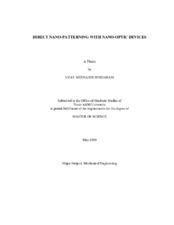| dc.description.abstract | In this study nano-patterning was carried out using two different nano-optic devices namely- the NSOM and Fresnel zone plate. In the first study, NSOM was used to generate nano-patterns on selected semiconducting (Si and Ge) and metallic (Cr, Cu and Ag) targets under different laser pulse durations, laser energies and number of laser pulses. Based on the experimental results, femtosecond laser pulses, provided lower pattern generation thresholds on targets but higher damage thresholds to the NSOM probes at the wavelength (~400-410 nm) studied, compared with nanosecond laser pulses. Three different mechanisms were identified as the dominant processes for pattern generation under different conditions, namely nano-scale laser ablation, nano-scale thermal oxidation and nano-scale melting/recrystallization of the targets. Furthermore, the resulting nano-patterns also showed a significant dependence on the optical properties (i.e., absorption coefficient and surface reflectivity) of the target material. By comparing the obtained experimental results, it was concluded that the optical energy transport from the NSOM probe to the target dominates the pattern generation when femtosecond laser is applied to the NSOM system. When nanosecond laser is applied, both the thermal and optical energy transported from the NSOM probe to the targets attribute to the obtained morphology of nano-patterns on different targets under the experimental conditions studied. In the second study, a traditional Fresnel zone plate with a focus length of 3 micrometres was fabricated with a novel lift-off process in e-beam lithography. The fabrication process involved, using a HSQ/PMMA bi-layer in a negative tone lift-off process with a layer of conducting polyaniline for charge dissipation. HSQ was used as the high resolution negative resist for e-beam patterning and the PMMA under-layer was used to enable a HSQ lift-off process. The fabricated Fresnel zone plate was used to generate nano-patterns on a UV sensitive photoresist using nanosecond laser light with lamda~409nm. The smallest pattern sizes generated was close to the diffraction limit. Nano-pattern sizes generated on the photoresist were comparable with a numerically calculated intensity distribution at the focus spot of the designed Fresnel zone plate obtained from Scalar Diffraction Theory. | en |


